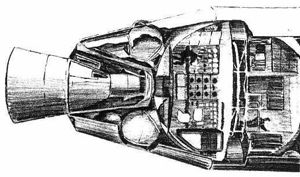MOL (original) (raw)

Home - Search - Browse - Alphabetic Index: 0- 1- 2- 3- 4- 5- 6- 7- 8- 9
A- B- C- D- E- F- G- H- I- J- K- L- M- N- O- P- Q- R- S- T- U- V- W- X- Y- Z
MOL

MOL
Manned Orbiting Laboratory, Final Design
Credit: © Mark Wade
American manned space station. Cancelled 1969. MOL (Manned Orbiting Laboratory) was the US Air Force's manned space project after Dynasoar was cancelled, until it in turn was cancelled in 1969. The earth orbit station used a helium-oxygen atmosphere.
AKA: AFP-632;Dorian;Dorian, AFP-632, KH-10;KH-10;Manned Orbiting Laboratory. Status: Operational 1966. First Launch: 1966-11-03. Last Launch: 1966-11-03. Number: 1 . Payload: 2,700 kg (5,900 lb). Gross mass: 14,476 kg (31,914 lb). Unfuelled mass: 14,376 kg (31,693 lb). Specific impulse: 255 s. Height: 21.92 m (71.91 ft). Diameter: 3.05 m (10.00 ft).
The crew rode the station to orbit and returned to earth aboard a Gemini-B capsule that was part of the station - no rendezvous or docking was required. Experiments planned ranged the gamut from military reconnaissance using large optical cameras and side-looking radar, through interception and inspection of satellites, to exploring the usefulness of man in space and test of Manned Maneuvering Units.
After cancellation, some of the reconnaissance systems ended up in later KH series satellites, and some of the manned experiments were accomplished on Skylab.
Crew Size: 2. Orbital Storage: 40 days. Habitable Volume: 11.30 m3. Spacecraft delta v: 101 m/s (331 ft/sec). Electric System: 2,000.00 kWh. Electric System: 2.00 average kW.
Subtopics
| Gemini B AM American manned spacecraft module. Cancelled 1969. Adapter module for Gemini B, the engines serving as both abort motors during ascent to orbit and for retrofire on return to earth. Abort/deorbit propulsion. |
|---|
| Gemini B RM American manned spacecraft. Cancelled 1969. Gemini was extensively redesigned for the MOL Manned Orbiting Laboratory program. The resulting Gemini B, although externally similar, was essentially a completely new spacecraft. Reentry capsule. |
|---|
| MOL LM American manned space station module. Cancelled 1969. The Laboratory Module consisted of a forward unpressurized section 2.43 m long, followed by an aft pressurized section, a 3.37 m long cylinder with 2.79 m diameter hemispherical bulkheads at each end. Space station military. |
|---|
| MOL MM American manned space station module. Cancelled 1969. The MOL Mission Module took up most of the spacecraft. It had a length of 11.24 m and was divided into two major bays, the forward section 4.42 m long, and the aft section 6.82 m long. |
|---|
| MOL Space Suit American space suit. Cancelled 1969. Space suit designed to support launch/re-entry and Extra-Vehicular Activity (EVA) aboard the USAF Manned Orbiting Laboratory. Developed from 1965-1969, when MOL was cancelled. |
|---|
| MOL 3 At the time of the cancellation of the MOL program in June 1969, the first manned mission was planned for early 1972. A crew of two would have spent thirty days in orbit operating sophisticated military reconnaissance equipment and other experiments. |
|---|
| MOL 4 Planned date of second manned MOL mission at time of the program cancellation. |
|---|
| MOL 5 Planned date of third manned MOL mission at time of the program cancellation. |
|---|
| MOL 6 Planned date of fourth manned MOL mission at time of the program cancellation. From the beginning of the project, the Navy had demanded that this be an all-Navy crew, which would limit the crew to Truly, with either Overmyer or Crippen as co-pilot. |
|---|
| MOL 7 Planned date of fifth manned MOL mission. This mission was already deleted from the FY 1970 budget request in April 1969, two months before the entire project was cancelled. |
|---|
Family: Space station, Surveillance orbit, USA - Space Stations. Country: USA. Spacecraft: Gemini B AM, Gemini B RM, MOL LM, MOL MM. Launch Vehicles: Titan, Titan II, Titan IIIC, Titan 3M. Propellants: Solid. Launch Sites: Cape Canaveral, Vandenberg, Cape Canaveral LC40. Agency: USAF, Douglas. Bibliography: 128, 137, 16, 2, 22, 26, 279, 28, 376, 54, 88.
Photo Gallery
 |
MOLCredit: © Dan Roam |
|---|
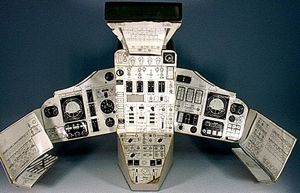 |
Gemini B PanelGemini B control panel, as would be used in the MOL project, showing numerous changes from NASA Gemini.Credit: Glen Swanson |
|---|
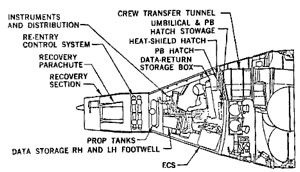 |
Gemini BGemini B cross-sectionCredit: McDonnell Douglas |
|---|
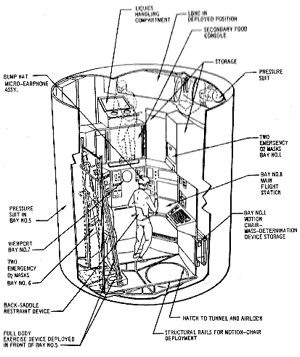 |
MOL LM View 2MOL Lab Module cutawayCredit: McDonnell Douglas |
|---|
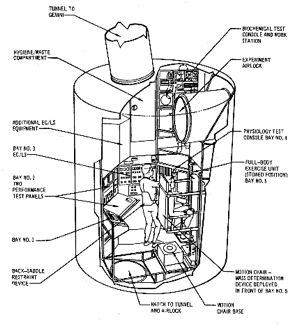 |
MOL LM View 1MOL Lab Module cutawayCredit: McDonnell Douglas |
|---|
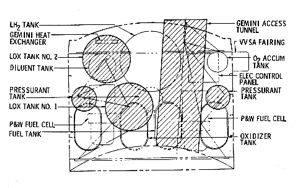 |
MOL LM ForwardMOL Lab Module forward unpressurised sectionCredit: McDonnell Douglas |
|---|
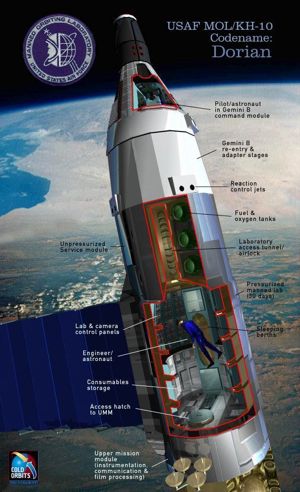 |
MOL Full SizeCredit: © Dan Roam |
|---|
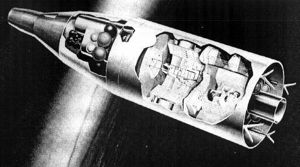 |
MOL early designMOL early design conceptCredit: © Mark Wade |
|---|
 |
MOL seen from GeminiMOL seen from Gemini over hurricaneCredit: © Mark Wade |
|---|
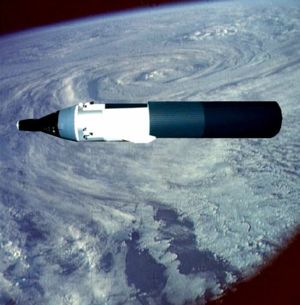 |
MOL in flightMOL in flight over PacificCredit: © Mark Wade |
|---|
 |
MOL in flightMOL in flight over Sinai PeninsulaCredit: © Mark Wade |
|---|
 |
MOL seen from GeminiMOL seen from Gemini over Sinai PeninsulaCredit: © Mark Wade |
|---|
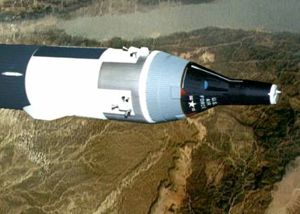 |
MOL in flightMOL in flight over Sinai PeninsulaCredit: © Mark Wade |
|---|
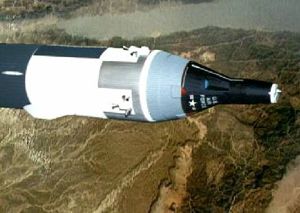 |
MOL seen from GeminiMOL seen from Gemini over Sinai PeninsulaCredit: © Mark Wade |
|---|
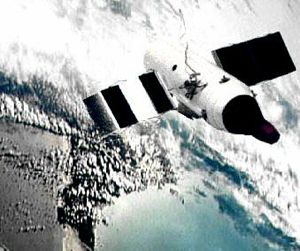 |
MOLMOL as it actually would have appeared in spaceCredit: © Mark Wade |
|---|
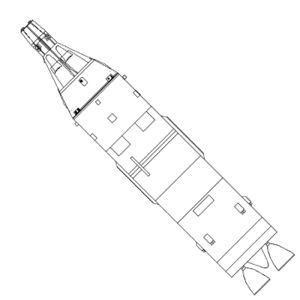 |
Manned Orbiting LabManned Orbiting LaboratoryCredit: © Mark Wade |
|---|
 |
MOL MockupCredit: Manufacturer Image |
|---|
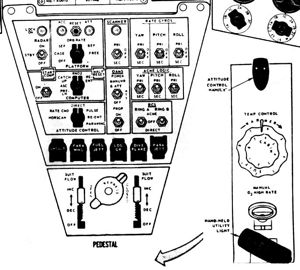 |
Gemini Control PanelGemini control panel - close-up of the pedestal controls between the two astronauts.Credit: NASA |
|---|
 |
Gemini SpacecraftCredit: © Mark Wade |
|---|
1959 June 22 - .
- Preliminary design of a two-man space laboratory. - . Nation: USA. Spacecraft: Gemini, MOL.
H. Kurt Strass of Space Task Group's Flight Systems Division (FSD) recommended the establishment of a committee to consider the preliminary design of a two-man space laboratory. Representatives from each of the specialist groups within FSD would work with a special projects group, the work to culminate in a set of design specifications for the two-man Mercury.
1962 May 23 - . LV Family: Titan. Launch Vehicle: Titan II.
- Avco proposal for a space station. - . Nation: USA. Spacecraft: MOL.
Representatives from Avco Manufacturing Corporation made a presentation to MSC on a proposal for a space station. Prime purpose of the station, company spokesmen said, was to determine the effects of zero-g on the crew's ability to stand reentry and thus fix the limit that man could safely remain in orbit. Avco's proposed station design comprised three separate tubes about 3 m in diameter and 6 m long, launched separately aboard Titan IIs and joined in a triangular shape in orbit. A standard Gemini spacecraft was to serve as ferry vehicle.
1963 July 22 - .
- Johnson requests statement on the importance to national security of a space station. - . Nation: USA. Spacecraft: Dynasoar, MOL. Vice President Lyndon B. Johnson requested the Secretary of the Defense to prepare a statement on the importance to national security of a space station..
1963 August 9 - .
- McNamara sees necessity of multi-manned orbital flights of long duration. - . Nation: USA. Spacecraft: Dynasoar, MOL. In his reply to the Vice President, Secretary McNamara stressed the necessity of multi-manned orbital flights of long duration..
1963 August 30 - .
- Study for a military, orbiting, space station. - . Nation: USA. Spacecraft: Dynasoar, MOL. The Director of Defense for Research and Engineering approved a study program for a military, orbiting, space station..
1963 September 12 - .
- Gemini, Apollo, and X-20 studied for military space missions. - . Nation: USA. Spacecraft: Apollo CSM, Dynasoar, Gemini, MOL.
The President's Scientific Advisory Committee requested a briefing from the Air Force on possible military space missions, biomedical experiments to be performed in space, and the capability of Gemini, Apollo, and the X-20 vehicles to execute these requirements.
1963 November 14 - .
- Cancellation of X-20 program proposed. - . Nation: USA. Spacecraft: Dynasoar, MOL.
The Director of Defense for Research and Engineering recommended to the Secretary of Defense cancellation of the X-20 program and initiation of a space station program. Harold Brown believed that Blue Gemini could accommodate significantly greater payload for such missions. He recommended that DynaSoar be cancelled and replaced by a Gemini-serviced space station.
1963 November 30 - .
- MOL orbiting laboratory program suggested. - . Nation: USA. Spacecraft: Dynasoar, MOL. Largely because of NASA objections to the space station proposal, Dr. Brown suggested to the Secretary of Defense an orbiting laboratory program, employing Gemini capsule and a 1,500 cubic foot test module..
1963 December 4 - .
- Military space station program which employed the X-20 proposed. - . Nation: USA. Spacecraft: Dynasoar, MOL.
In a memorandum to the Secretary of the Air Force, Dr. Flax disagreed with Dr. Brown's space station proposal and argued against the cancellation of the X-20. Secretary Zuckert informed the Secretary of Defense that he supported the posit of Dr. Flax. Major General I. K. Hester, Assistant Vice Chief of Staff, offered a space station program which employed the X-20.
1963 December 5 - .
- X-20 proposed as part of a space station program. - . Nation: USA. Spacecraft: Dynasoar, MOL. Secretary Zuckert forwarded General Hester's proposal to the Secretary of Defense and stated that there was no reason to omit the X-20 from consideration as part of a space station program..
1963 December 10 - .
- Cancellation of the X-20 DynaSoar project and start of the MOL project - . Nation: USA. Related Persons: McNamara. Spacecraft: Dynasoar, MOL.
Secretary of Defense Robert S. McNamara announced cancellation of the X-20 Dyna Soar project at a news briefing at the Pentagon. McNamara stated that fiscal resources thereby saved would be channeled into broader research on the problems and potential value of manned military operations in space, chiefly the Manned Orbiting Laboratory (MOL) project. These decisions on the X-20 and MOL had been discussed and coordinated with NASA, and, although the Air Force received responsibility for the MOL project, NASA would continue to provide technical support. By the end of 1963 410millionhadbeenspentonDynasoar,withanother410 million had been spent on Dynasoar, with another 410millionhadbeenspentonDynasoar,withanother373 million needed through the first flight. It was decided to complete re-entry testing of the Asset subscale unmanned vehicle, at a cost of $ 41 million.
1963 December 10 - . LV Family: Titan. Launch Vehicle: Titan IIIM.
- Manned Orbiting Laboratory assigned to USAF - . Related Persons: , McNamara. Spacecraft: MOL.
Secretary of Defense Robert S. McNamara assigned responsibility for the development of a near-earth Manned Orbiting Laboratory (MOL) to the Air Force. First manned flight was tentatively planned for late 1967 or early 1968. A modified Titan III, the Titan HIM, would be used to place the laboratories in orbit from Vandenberg.
1963 December 16 - .
- Military manned space effort responsibility. - . Related Persons: Schriever. Spacecraft: MOL. General Bernard A. Schriever, AFSC Commander, assigned Space Systems Division the responsibility for managing the entire military manned space effort, including the Manned Orbiting Laboratory (MOL)..
1963 December 19 - .
- NASA position on the Defense Department's Manned Orbiting Laboratory project. - . Nation: USA. Related Persons: McNamara, Webb. Spacecraft: MOL.
NASA Hq advised the centers regarding the agency's official position vis-a-vis the Defense Department's Manned Orbiting Laboratory project. Both NASA and DOD viewed MOL as a project designed to fulfill immediate military requirements. The project could not be construed as meeting the much broader objectives and goals of a national space station program being studied by both organizations under post-Apollo research and development program policy agreements between NASA Administrator James E. Webb and Secretary of Defense Robert S. McNamara (dated 14 September 1963).
1963 December 31 - .
- NASA/USAF discussions on MOL joint control and support. - . Nation: USA. Related Persons: Gilruth, Mueller. Spacecraft: MOL.
MSC Director Robert R. Gilruth apprised George E. Mueller, Associate Administrator for Manned Space Flight, of recent discussions with officers from the Air Force's Space Systems Division regarding MSC's joint participation in the MOL project in the area of operational control and support. Such joint cooperation might comprise two separate areas: manning requirements for the control center and staffing of actual facilities. Gilruth suggested that such joint cooperation would work to the benefit of both organizations involved. Furthermore, because a number of unidentified problems inevitably existed, he recommended the creation of a joint NASA Air Force group to study the entire question so that such uncertainties might be identified and resolved.
1964 January-March - .
- Air Force's Manned Orbiting Laboratory and NASA's Manned Orbiting Research Laboratory studied. - . Nation: USA. Spacecraft: MOL.
In the wake of the Air Force's Manned Orbiting Laboratory project and the likelihood of NASA's undertaking some type of manned orbiting research laboratory, Director of Advanced Manned Missions Studies Edward Z. Gray sought to achieve within NASA a better understanding of the utility of such projects as a base for experiments in space. Accordingly, he created three separate working groups to deal with possible experiments in three separate categories: (l) big-medical, (2) scientific, and (3) engineering.
1964 January 10 - .
- Manned Orbiting Laboratory "an ominous harbinger...". - . Nation: USA. Spacecraft: MOL.
James J. Haggerty, Jr., Space Editor for the Army-Navy-Air Force Journal and Register, called the assignment of the Manned Orbiting Laboratory to the Department of Defense 'an ominous harbinger of a reversal in trend, an indication that the military services may play a more prominent role in future space exploration at NASA's expense.... Whether you label it development platform, satellite platform, satellite or laboratory, it is clearly intended as a beginning for space station technology. It is also clearly the intent of this administration that, at least in the initial stages, space station development shall be under military rather than civil cognizance....'
1964 February 1 - .
- Executive agent for the Manned Orbiting Laboratory (MOL) spacecraft. - . Spacecraft: MOL. Space Systems Division was named the Air Force executive agent for the Manned Orbiting Laboratory (MOL) spacecraft..
1964 February 15 - .
- American space plans - . Nation: Russia. Related Persons: Bykovsky, Gagarin. Spacecraft: Almaz APOS, MOL, Soyuz PPK, Soyuz R.
Following an overview of the planned trip of Bykovsky and Gagarin to Sweden and Norway on 1-15 March, American military space plans are reviewed. There are many fantastic projects, over a wide and well-financed front. Currently reconnaissance satellites are flying, to be followed by inspection, and then anti-satellite satellites in 3 to 5 years. After that manned military space stations are planned, manoeuvrable manned spacecraft, and the establishment of scientific and military bases on the moon. Despite this big US program, the Soviet military leadership shows no interest in Russian exploitation of space for military purposes.
1964 June 5 - . LV Family: Titan. Launch Vehicle: Titan IIIC.
- Three firms received authorization to begin work on space station studies. - . Nation: USA. Spacecraft: MOL.
Secretary of the Air Force Eugene M. Zuckert announced that three firms, Douglas Aircraft Company, General Electric Company, and The Martin Company, had received authorization to begin work on space station studies. Zuckert predicted also that the Titan III would be test-flown that summer and would launch the Manned Orbiting Laboratory sometime in 1967 or 1968.
1964 December 7 - .
- Recommendation that the Air Force's MOL and NASA's Apollo X programs be merged. - . Nation: USA. Related Persons: Johnson, Lyndon. Spacecraft: Apollo X, MOL.
In a letter to President Lyndon B. Johnson, Senator Clinton P. Anderson, Chairman of the Committee on Aeronautical and Space Sciences, recommended that the Air Force's MOL and NASA's Apollo X programs be merged. Senator Anderson argued that a jointly operated national space station program would most effectively use the nation's available resources. He claimed that $1 billion could be saved during the next five years if the MOL were canceled and those funds applied to NASA's Apollo-based space station program. Additional Details: here....
1965 January 23 - .
- Department of Defense requesting proposals for design / development of the MOL. - . Nation: USA. Related Persons: McNamara. Spacecraft: MOL.
Defense Secretary Robert S. McNamara announced that the Department of Defense was requesting proposals from the aerospace industry for design studies to support development of the MOL (especially cost and technical data). Three contractors would be chosen to conduct the studies, a step preliminary to any DOD decision to proceed with full-scale development of the space laboratory.
1965 August 24 - .
- Soyuz-VI program started.. - . Nation: Russia. Related Persons: Kozlov. Flight: Gemini 4, Soyuz VI Flight 1. Spacecraft Bus: Soyuz. Spacecraft: Soyuz VI, Gemini, MOL.
Central Committee of the Communist Party and Council of Soviet Ministers Decree 'On expansion of military space research and on 7K-VI Zvezda' was issued. In June 1965 Gemini 4 began the first American experiments in military space. At the same time the large military Manned Orbital Laboratory space station was on the verge of being given its final go-ahead. These events caused a bit of a panic among the Soviet military, where the Soyuz-R and Almaz projects were in the very earliest stages of design and would not fly until 1968 at the earliest. VPK head Leonid Smirnov ordered that urgent measures be taken to test manned military techniques in orbit at the earliest possible date. Modifications were to be made to the Voskhod and Soyuz 7K-OK spacecraft to assess the military utility of manned visual and photographic reconnaissance; of inspection of enemy satellites from orbit; attacking enemy spacecraft; and obtaining early warning of nuclear attack. The decree instructed Kozlov to fly by 1967 a military research variant of the Soyuz 7K-OK 11F615.
1965 August 25 - .
- Manned Orbiting Laboratory (MOL). - . Nation: USA. Related Persons: Johnson, Lyndon. Spacecraft: MOL.
President Johnson announced approval for the Department of Defense's 1.5−billionMannedOrbitingLaboratory(MOL).AtaWhiteHousenewsconference,PresidentLyndonB.JohnsonannouncedapprovalfortheDepartmentofDefense′sdevelopmentofthe1.5-billion Manned Orbiting Laboratory (MOL). At a White House news conference, President Lyndon B. Johnson announced approval for the Department of Defense's development of the 1.5−billionMannedOrbitingLaboratory(MOL).AtaWhiteHousenewsconference,PresidentLyndonB.JohnsonannouncedapprovalfortheDepartmentofDefense′sdevelopmentofthe1.5-billion Manned Orbiting Laboratory (MOL). Such a program, the President said, would bring 'new knowledge about what man is able to do in space.' Further, MOL 'will enable us to relate that ability to the defense of America.'
1965 August 25 - . Launch Site: Vandenberg. Launch Complex: Vandenberg. LV Family: Titan. Launch Vehicle: Titan 3M.
- MOL to be launched from Canaveral and Vandenberg - . Nation: USA. Related Persons: Johnson, Lyndon. Class: Manned. Type: Manned space station. Spacecraft: MOL. DoD revealed that newly-authorized Manned Orbiting Laboratory (MOL) program (announced by President Lyndon Johnson the same day) would be launched from both the Air Force Eastern and Western Test Ranges..
1965 August 25 - . LV Family: Titan. Launch Vehicle: Titan IIIM.
- Development of Manned Orbiting Laboratory approved. - . Spacecraft: MOL.
President Lyndon B. Johnson announced that he had approved the Defense Department plans for the development of a Manned Orbiting Laboratory (MOL) that would cost $1. 5 billion. The Air Force was to continue its management of the MOL program. Douglas Aircraft Company was to design and build the spacecraft that would be boosted into orbit by the Titan IIIM version of the Titan IIIC space launch vehicle.
1965 August 31 - .
- Schriever named Director of the Manned Orbiting Laboratory (MOL) Program. - . Related Persons: Schriever. Spacecraft: MOL, MOL.
Secretary of the Air Force Eugene M. Zuckert named General Bernard A. F. Schriever as Director of the Manned Orbiting Laboratory (MOL) Program in addition to his duties as Commander, AFSC. Brigadier General Harry L. Evans was named Vice Director of the MOL Program.
1965 December 29 - .
- NASA support to the Air Force on the MOL summarized. - . Nation: USA. Spacecraft: MOL.
In the initial activity report outlining MSC's support to the Air Force on the MOL, Gemini Program Manager Charles W. Mathews summarized activity to date. He cited receipt on 20 November 1965 of authority to transfer surplus Gemini equipment to the MOL project. Since that time, he said, MSC had delivered to the Air Force several boilerplate test vehicles and a variety of support and handling equipment. MOL program officials and astronauts had also visited Houston for technical discussions and briefings.
1966 March 12 - . Launch Site: Vandenberg. Launch Complex: Vandenberg. LV Family: Titan. Launch Vehicle: Titan IIIC.
- Start of construction (site preparation) for SLC-6 - . Nation: USA. Class: Manned. Type: Manned space station. Spacecraft: MOL. Start of construction (site preparation) for Space Launch Complex 6 facilities at former Sudden Ranch property..
1966 March 21 - .
- NASA's Apollo Applications Program should be comined the Air Force's Manned Orbiting Laboratory. - . Nation: USA. Spacecraft: Apollo X, MOL.
House Committee recommended combining NASA's Apollo Applications Program with the Air Force's Manned Orbiting Laboratory. A report by the Military Operations Subcommittee of the House Committee on Government Operations recommended combining NASA's Apollo Applications Program with the Air Force's Manned Orbiting Laboratory. 'Inasmuch as both programs are still research and development projects without definitive operational missions,' stated the Committee's report, 'there is reason to expect that with earnest efforts both agencies could get together on a joint program incorporating both unique and similar experiments of each agency.'
1966 May 20-21 - .
- USAF and NASA coordinate medical experiments for the Air Force's MOL project and NASA's AAP. - . Nation: USA. Spacecraft: MOL.
Representatives of the Air Force and NASA met at Brooks AFB, Texas, to exchange information on medical experiments planned for the Air Force's MOL project and NASA's AAP. Stanley White, who headed the USAF group of aerospace medical experts, expressed strong interest in exploiting NASA's AAP project to study the effects of long-duration space flight on human life processes. White stated the Air Force's desire that MOL thus be relieved of this experiment burden so program planners could direct the program more closely toward evaluating man's utility for military space operations. The meeting furnished the basis for closer ties between the two organizations on their biomedical activities, observed NASA's Acting Director of Space Medicine, Jack Bollerud.
1966 November 3 - . 13:50 GMT - . Launch Site: Cape Canaveral. Launch Complex: Cape Canaveral LC40. LV Family: Titan. Launch Vehicle: Titan IIIC.
- MOL Mockup - . Payload: MOL Mockup (Titan fuel tank). Mass: 9,680 kg (21,340 lb). Nation: USA. Agency: USAF. Class: Manned. Type: Manned space station. Spacecraft: MOL. COSPAR: 1966-099xx.
A Titan IIIC (Vehicle #9), the ninth research and development Titan III and sixth Titan IIIC to be launched from Cape Canaveral, completed the most difficult flight plan and most successful mission to date. The primary objective of injecting a modified Gemini spacecraft into a suborbital trajectory to test the reentry heat shield for the Manned Orbiting Laboratory (MOL) program was accomplished. After dipping down to 80 nautical miles to eject the MOL load, the Transtage pitched up and placed a canister containing 11 experiments into a 160-nautical mile circular orbit. This modified Titan 2 propellant tank represented the MOL station itself. It allowed study of the aerodynamic loads associated with launching the MOL into orbit and validated the very long length to diameter core represented by the MOL/Titan 3M configuration. It is possible certain prototype MOL equipment was flown as well.
1967 February 14 - .
- MOL major subcontractors selected - . Nation: USA. Spacecraft: MOL. MOL major subcontractors announced by prime contractor Douglas: Republic for the waste management system; Marquardt for 45 kgf and 20 kgf orientation thrusters; IBM for computers; Garrett for ECS; Scientific Data Systems for ground support equipment..
1967 March - .
- NASA / USAF MOL Collaboration - . Nation: USA. Spacecraft: MOL.
NASA agrees to fly four Deparment of Defense experiments planned for MOL on Apollo Applications mission instead (later Skylab). These included an inflatable airlock experiment. NASA also provided the Gemini 6 capsule to the Air Force for MOL crew training.
1967 March 20 - .
- MOL project delays, cost growth. - . Nation: USA. Spacecraft: MOL.
Weight growth of the MOL station forced the Air Force to consider upgrading of the Titan booster. Stretching of the booster core or use of 156 inch solid rocket motors was considered. The Air Force also dithered as to whether to compete the Titan booster contract. Eight months were spent making the decision, and at the end of it all the first manned MOL flight was delayed to 1970 and the projected total cost increased from $ 1.5 billion to $ 2.2 billion.
1967 May 2 - .
- NASA briefing to Manned Orbiting Laboratory staff on fire hazards - . Nation: USA. Program: Apollo. Spacecraft: MOL.
The Air Force Manned Orbiting Laboratory Systems Program Office requested that MSC present a briefing to selected office and contractor personnel on NASA's progress in safety studies and tests associated with fire hazards aboard manned space vehicles. Information was requested for the MOL program to help formulate studies and activities that would not duplicate MSC efforts. The briefing was given at MSC May 10.
1968 March 1 - .
- MOL qualification test underway. - . Nation: USA. Spacecraft: MOL. The MOL mockup was completed, static structural test of flight representative assemblies was underway, and major equpment was in qualification test..
1969 April 27 - . LV Family: Titan. Launch Vehicle: Titan 3M.
- First static test firing of Titan 3M SRB. - . Nation: USA. Spacecraft: MOL. First test firing of seven segment solid rocket booster motor for Titan 3M for MOL. The test at Coyote Canyon, California, generated 0.7 million kgf for two minutes..
1969 June 10 - . Launch Site: Vandenberg. Launch Complex: Vandenberg. LV Family: Titan. Launch Vehicle: Titan IIIC.
- MOL Program cancelled - . Nation: USA. Class: Manned. Type: Manned space station. Spacecraft: MOL.
Deputy Secretary of Defense David Packard announced the cancellation of the Air Force's Manned Orbiting Laboratory (MOL) program because of the need to reduce defense spending. The cancellation was expected to save $ 1.5 billion of the projected total $ 3.0 billion program costs. The SLC-6 launch facility at Vandenberg, 90% complete, would be finished and mothballed. MOL reconnaisance systems useful on unmanned satellites would be completed for a total cost of $ 225 million. Ten thousand aerospace workers were laid off as a result of the cancellation. The program was initiated in 1965 to advance the development of both manned and unmanned defense-oriented space equipment and to ascertain the full extent of man's utility in space for defense purposes. Following MOL termination, NASA requested that the MOL food and diet contract with Whirlpool Corporation and the space suit development contract with Hamilton Standard Division, United Aircraft Corporation, be transferred to NASA.
1969 August 4 - .
- Seven astronauts from the defunct MOL project transferred to NASA - . Nation: USA. Related Persons: Mueller. Spacecraft: MOL.
Acting on an offer made by the Defense Department to assign a number of astronauts from the defunct MOL project to NASA, Associate Administrator for Manned Space Flight George E. Mueller chose seven astronauts to augment MSC's flight crews. They were Karol J. Bobko, Charles G. Fullerton, Henry W. Hartsfield, and Donald H. Peterson (USAF); Richard H. Truly and Robert L. Crippin (USN); and Robert F. Overmyer (USMC). The decision to utilize these individuals, Mueller stated, derived from their extensive training and experience on the MOL project and the important national aspect of future manned space flight programs.
1970 February 9 - .
- Manned Orbiting Laboratory environment conditioning units delivered. - . Nation: USA. Spacecraft: Apollo ATM, MOL, Skylab.
With the termination of the Manned Orbiting Laboratory, the Air Force provided MSFC with three environment conditioning units capable of delivering fresh air into a small enclosed space at a desired temperature and humidity. The units would be used during bench checks and troubleshooting on the ATM experiments and the related ground support equipment during storage and the preinstallation period.
1970 Late - . LV Family: Titan. Launch Vehicle: Titan 3M.
- MOL 1 - . Nation: USA. Spacecraft: MOL. The first unmanned Gemini-B/Titan 3M qualification flight was planned for late 1970 at the time the program was cancelled..
1971 - . LV Family: Titan. Launch Vehicle: Titan 3M.
- MOL 2 - . Nation: USA. Spacecraft: MOL. The second unmanned Gemini-B/Titan 3M qualification flight would have taken place in 1971 and set the stage for the first manned mission in 1971..
1972 Early - . LV Family: Titan. Launch Vehicle: Titan 3M.
- MOL 3 (cancelled) - . Crew: Crews, Taylor. Nation: USA. Related Persons: Crews, Taylor. Flight: MOL 3. Spacecraft: MOL. At the time of the cancellation of the MOL program in June 1969, the first manned mission was planned for early 1972. A crew of two would have spent thirty days in orbit operating sophisticated military reconnaisance equipment and other experiments..
1972 Late - . LV Family: Titan. Launch Vehicle: Titan 3M.
- MOL 4 (cancelled) - . Nation: USA. Flight: MOL 4. Spacecraft: MOL. Planned date of second manned MOL mission at time of the program cancellation..
1973 - . LV Family: Titan. Launch Vehicle: Titan 3M.
- MOL 5 (cancelled) - . Nation: USA. Flight: MOL 5. Spacecraft: MOL. Planned date of third manned MOL mission at time of the program cancellation..
1974 - . LV Family: Titan. Launch Vehicle: Titan 3M.
- MOL 6 (cancelled) - . Crew: Crippen, Truly. Nation: USA. Related Persons: Crippen, Truly. Flight: MOL 6. Spacecraft: MOL. Planned date of fourth manned MOL mission at time of the program cancellation. From the beginning of the project, the Navy had demanded that this be an all-Navy crew..
1975 - . LV Family: Titan. Launch Vehicle: Titan 3M.
- MOL 7 (cancelled) - . Nation: USA. Flight: MOL 7. Spacecraft: MOL. Planned date of fifth manned MOL mission. This mission was already deleted from the FY 1970 budget request in April 1969, two months before the entire project was cancelled..
Home - Search - Browse - Alphabetic Index: 0- 1- 2- 3- 4- 5- 6- 7- 8- 9
A- B- C- D- E- F- G- H- I- J- K- L- M- N- O- P- Q- R- S- T- U- V- W- X- Y- Z
© 1997-2019 Mark Wade - Contact
© / Conditions for Use
